Abstract
Extracellular recordings of single unit activity were made in the substantia nigra (SN) of chloral hydrate-anaesthetized rats. Dopaminergic neurones of the pars compacta (SNC) were stimulated by (-)-nicotine bitartrate (1.0 mg kg-1) given subcutaneously (s.c.). This action was prevented by the secondary amine mecamylamine HCl (2.0 mg kg-1 i.v.) but not by a ganglion-blocking dose of the bisquaternary compound chlorisondamine Cl (0.1 mg kg-1 i.v.). Mecamylamine reduced the spontaneous activity of dopaminergic neurones. Nicotine, when administered intravenously (2-128 micrograms kg-1 cumulative dose), also stimulated dopamine cells and this action was dose-related. Nicotine, administered intravenously, (2-128 micrograms kg-1 cumulative dose) markedly excited non-dopamine cells in the pars reticulata (SNR) in a dose-related manner. In rats pretreated with chlorisondamine (0.1 mg kg-1 i.v.), nicotine induced a small excitatory or depressant action, but the marked excitation was not seen. Mecamylamine (2 mg kg-1 i.v.) completely prevented the actions of nicotine. The results are consistent with a direct excitatory action of nicotine on dopaminergic neurones of the substantia nigra pars compacta. The pronounced excitatory action of systemically administered nicotine on non-dopamine cells of the pars reticulata appears to be of peripheral origin.
Full text
PDF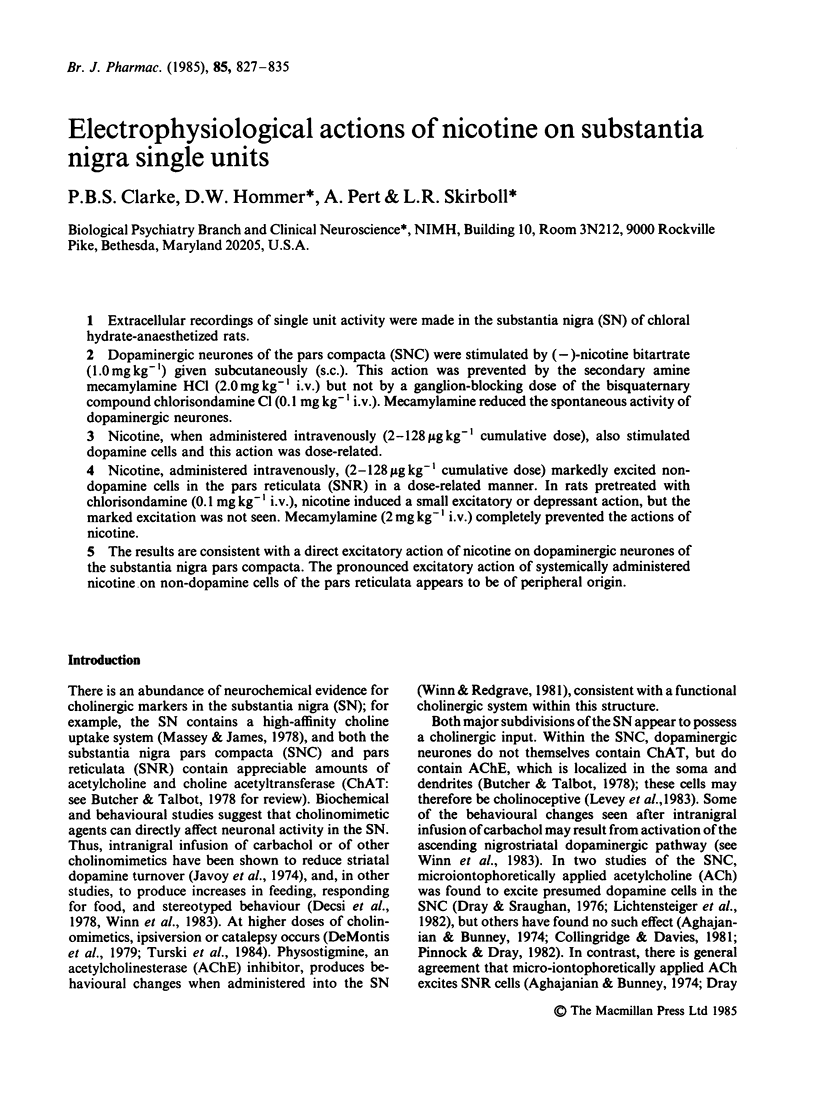
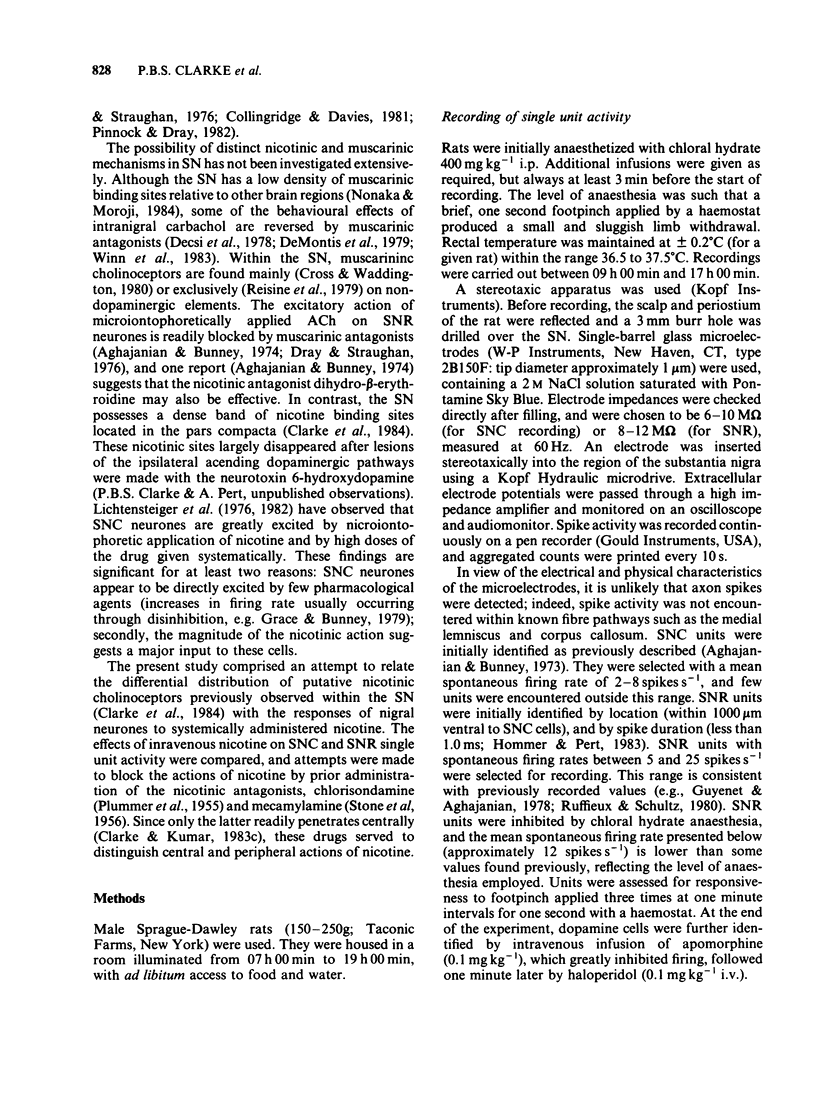
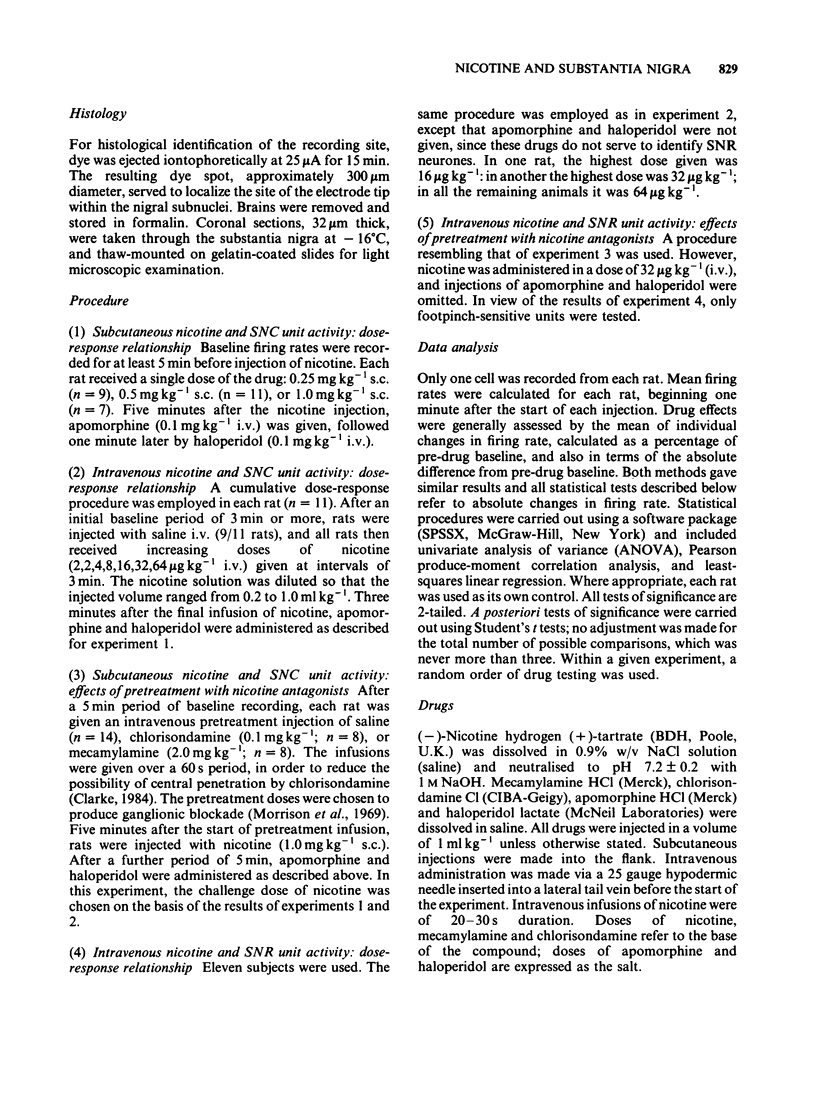
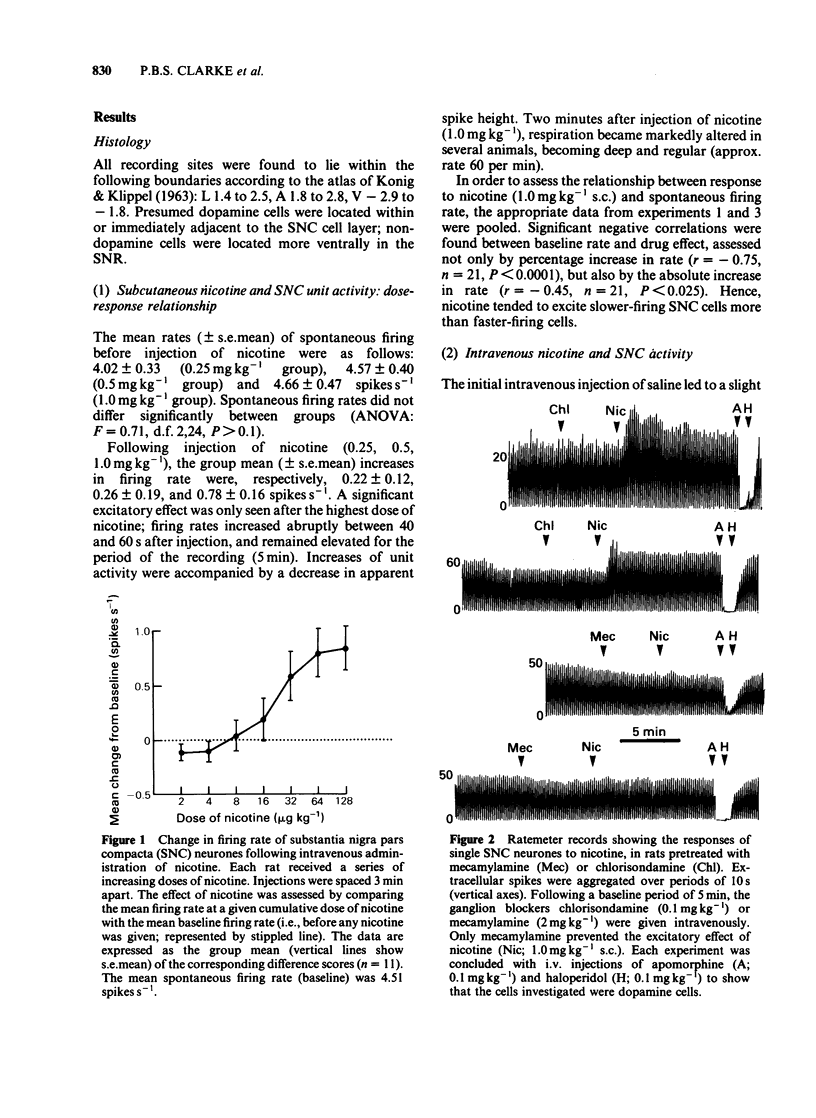
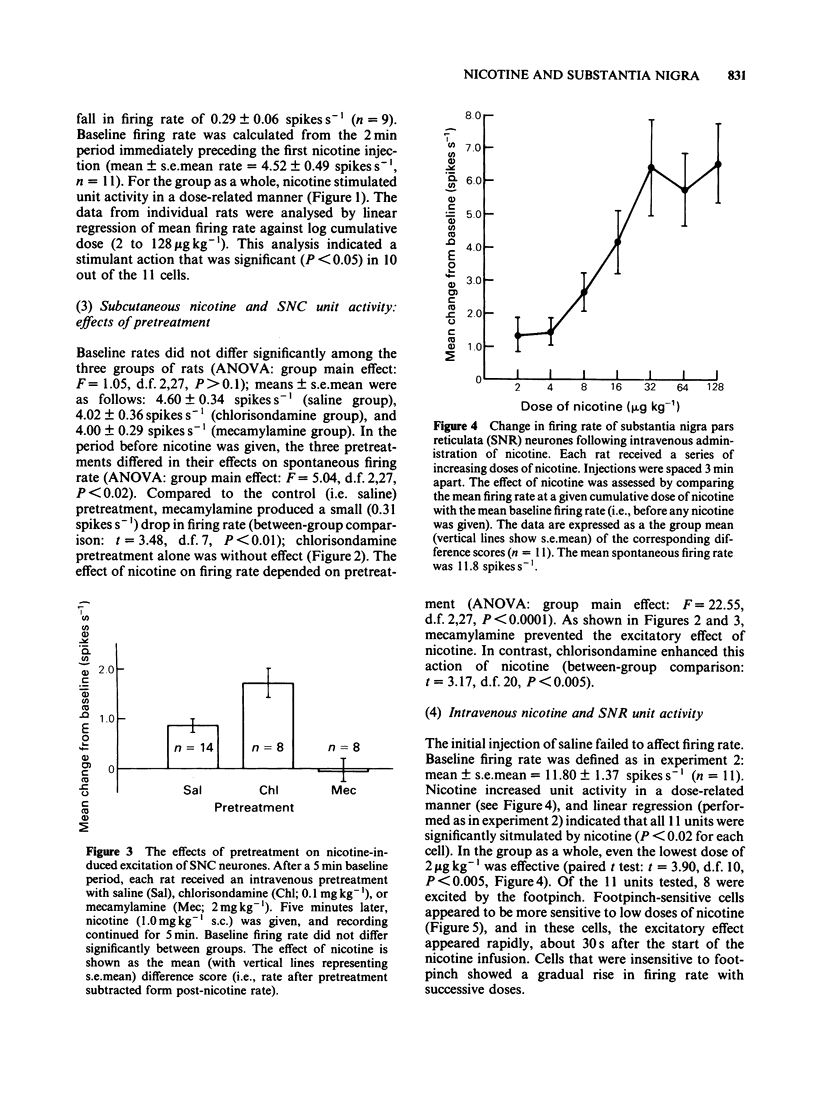
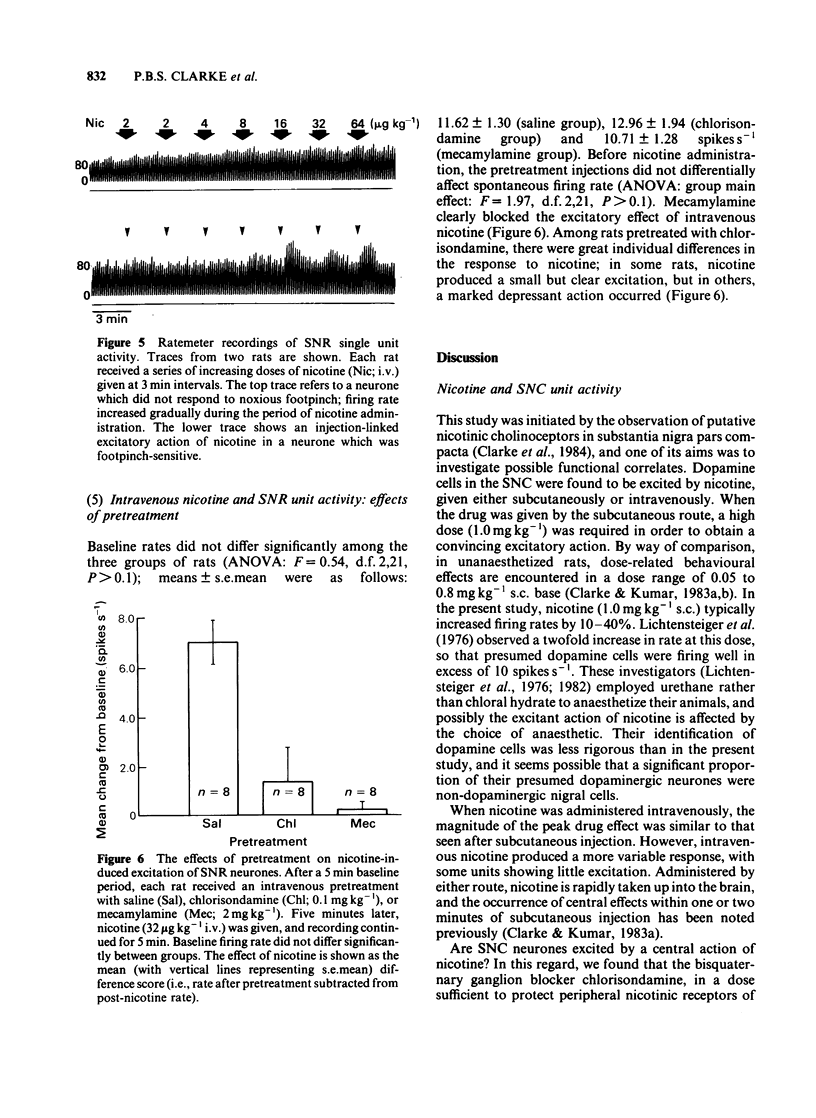
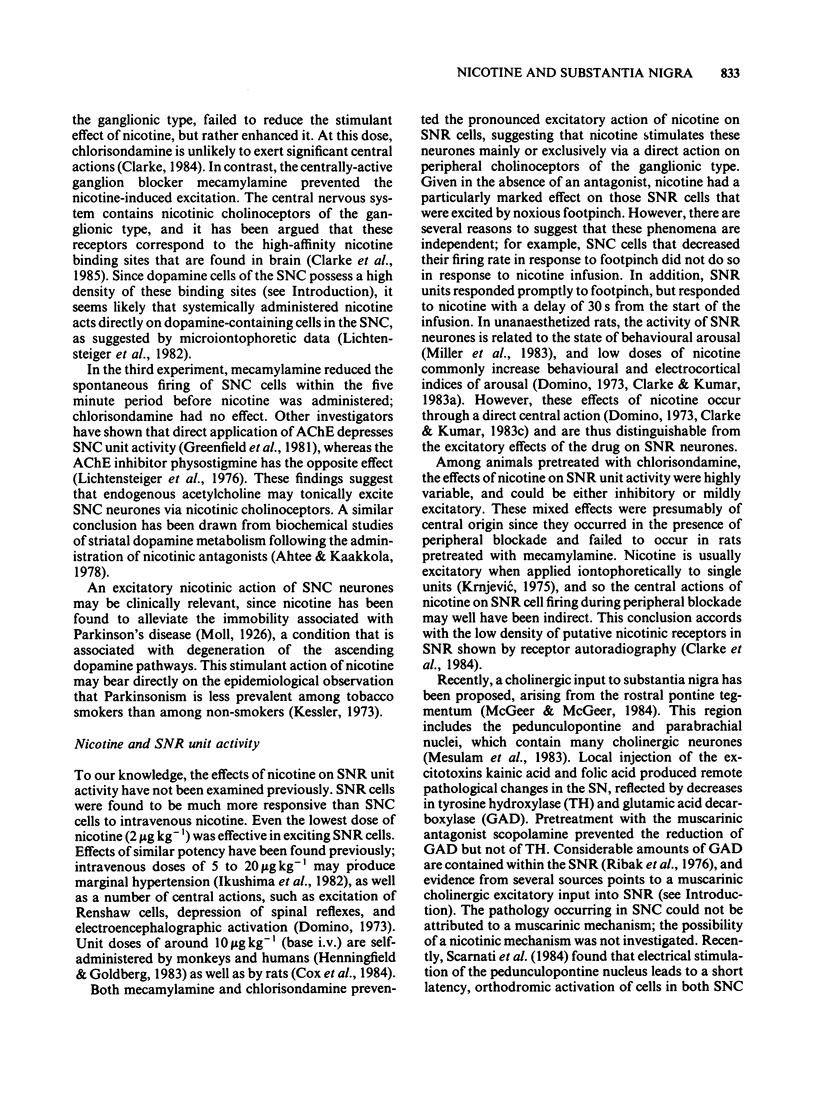
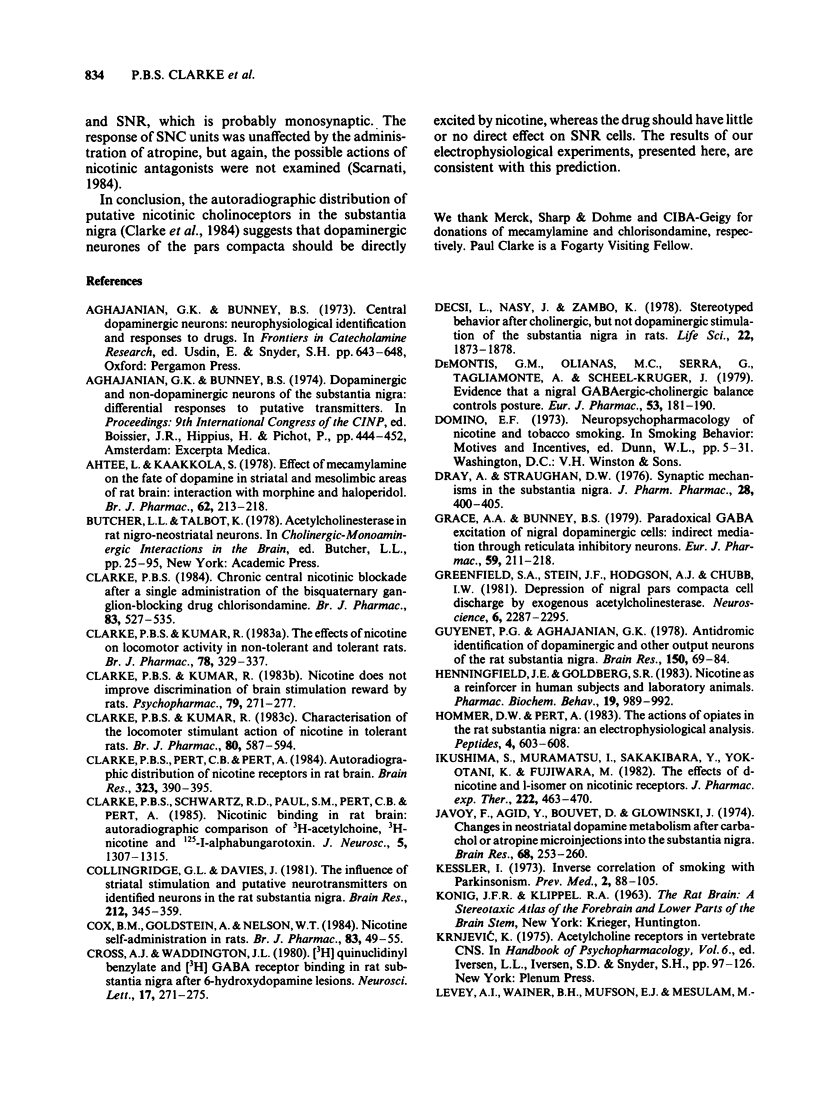
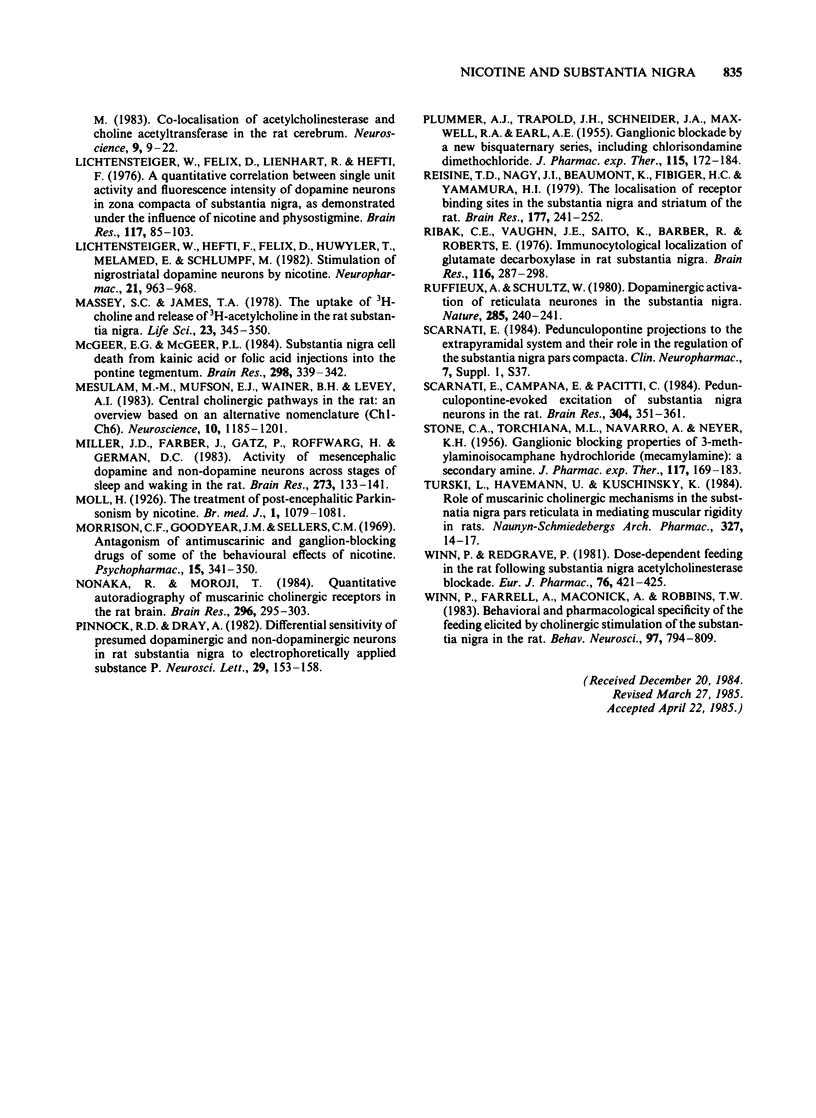
Selected References
These references are in PubMed. This may not be the complete list of references from this article.
- Ahtee L., Kaakkola S. Effect of mecamylamine on the fate of dopamine in striatal and mesolimbic areas of rat brain; interaction with morphine and haloperidol. Br J Pharmacol. 1978 Feb;62(2):213–218. doi: 10.1111/j.1476-5381.1978.tb08448.x. [DOI] [PMC free article] [PubMed] [Google Scholar]
- Clarke P. B. Chronic central nicotinic blockade after a single administration of the bisquaternary ganglion-blocking drug chlorisondamine. Br J Pharmacol. 1984 Oct;83(2):527–535. doi: 10.1111/j.1476-5381.1984.tb16517.x. [DOI] [PMC free article] [PubMed] [Google Scholar]
- Clarke P. B., Kumar R. Characterization of the locomotor stimulant action of nicotine in tolerant rats. Br J Pharmacol. 1983 Nov;80(3):587–594. doi: 10.1111/j.1476-5381.1983.tb10733.x. [DOI] [PMC free article] [PubMed] [Google Scholar]
- Clarke P. B., Kumar R. Nicotine does not improve discrimination of brain stimulation reward by rats. Psychopharmacology (Berl) 1983;79(2-3):271–277. doi: 10.1007/BF00427826. [DOI] [PubMed] [Google Scholar]
- Clarke P. B., Kumar R. The effects of nicotine on locomotor activity in non-tolerant and tolerant rats. Br J Pharmacol. 1983 Feb;78(2):329–337. doi: 10.1111/j.1476-5381.1983.tb09398.x. [DOI] [PMC free article] [PubMed] [Google Scholar]
- Clarke P. B., Pert C. B., Pert A. Autoradiographic distribution of nicotine receptors in rat brain. Brain Res. 1984 Dec 10;323(2):390–395. doi: 10.1016/0006-8993(84)90320-2. [DOI] [PubMed] [Google Scholar]
- Clarke P. B., Schwartz R. D., Paul S. M., Pert C. B., Pert A. Nicotinic binding in rat brain: autoradiographic comparison of [3H]acetylcholine, [3H]nicotine, and [125I]-alpha-bungarotoxin. J Neurosci. 1985 May;5(5):1307–1315. doi: 10.1523/JNEUROSCI.05-05-01307.1985. [DOI] [PMC free article] [PubMed] [Google Scholar]
- Collingridge G. L., Davies J. The influence of striatal stimulation and putative neurotransmitters on identified neurones in the rat substantia nigra. Brain Res. 1981 May 18;212(2):345–359. doi: 10.1016/0006-8993(81)90467-4. [DOI] [PubMed] [Google Scholar]
- Cox B. M., Goldstein A., Nelson W. T. Nicotine self-administration in rats. Br J Pharmacol. 1984 Sep;83(1):49–55. doi: 10.1111/j.1476-5381.1984.tb10118.x. [DOI] [PMC free article] [PubMed] [Google Scholar]
- Cross A. J., Waddington J. L. [3H] Quinuclidinyl benzylate and [3H] GABA receptor binding in rat substantia nigra after 6-hydroxy-dopamine lesions. Neurosci Lett. 1980 May 1;17(3):271–275. doi: 10.1016/0304-3940(80)90035-x. [DOI] [PubMed] [Google Scholar]
- De Montis G. M., Olianas M. C., Serra G., Tagliamonte A., Scheel-Krüger J. Evidence that a nigral gabaergic--cholinergic balance controls posture. Eur J Pharmacol. 1979 Jan 1;53(2):181–190. doi: 10.1016/0014-2999(79)90164-x. [DOI] [PubMed] [Google Scholar]
- Decsi L., Nagy J., Zámbó K. Stereotyped behaviour after cholinergic, but not dopaminergic, stimulation of the substantia nigra in rats. Life Sci. 1978 Jun 5;22(21):1873–1878. doi: 10.1016/0024-3205(78)90473-3. [DOI] [PubMed] [Google Scholar]
- Dray A., Straughan D. W. Synaptic mechanisms in the substantia nigra. J Pharm Pharmacol. 1976 Apr;28(4 Suppl):400–405. doi: 10.1111/j.2042-7158.1976.tb04187.x. [DOI] [PubMed] [Google Scholar]
- Grace A. A., Bunney B. S. Paradoxical GABA excitation of nigral dopaminergic cells: indirect mediation through reticulata inhibitory neurons. Eur J Pharmacol. 1979 Nov 16;59(3-4):211–218. doi: 10.1016/0014-2999(79)90283-8. [DOI] [PubMed] [Google Scholar]
- Greenfield S. A., Stein J. F., Hodgson A. J., Chubb I. W. Depression of nigral pars compacta cell discharge by exogenous acetylcholinesterase. Neuroscience. 1981;6(11):2287–2295. doi: 10.1016/0306-4522(81)90018-x. [DOI] [PubMed] [Google Scholar]
- Guyenet P. G., Aghajanian G. K. Antidromic identification of dopaminergic and other output neurons of the rat substantia nigra. Brain Res. 1978 Jul 7;150(1):69–84. doi: 10.1016/0006-8993(78)90654-6. [DOI] [PubMed] [Google Scholar]
- Henningfield J. E., Goldberg S. R. Nicotine as a reinforcer in human subjects and laboratory animals. Pharmacol Biochem Behav. 1983 Dec;19(6):989–992. doi: 10.1016/0091-3057(83)90405-7. [DOI] [PubMed] [Google Scholar]
- Hommer D. W., Pert A. The actions of opiates in the rat substantia nigra: an electrophysiological analysis. Peptides. 1983 Sep-Oct;4(5):603–608. doi: 10.1016/0196-9781(83)90004-9. [DOI] [PubMed] [Google Scholar]
- Ikushima S., Muramatsu I., Sakakibara Y., Yokotani K., Fujiwara M. The effects of d-nicotine and l-isomer on nicotinic receptors. J Pharmacol Exp Ther. 1982 Aug;222(2):463–470. [PubMed] [Google Scholar]
- Javoy F., Agid Y., Bouvet D., Glowinski J. Changes in neostriatal DA metabolism after carbachol or atropine microinjections into the substantia nigra. Brain Res. 1974 Mar 22;68(2):253–260. doi: 10.1016/0006-8993(74)90394-1. [DOI] [PubMed] [Google Scholar]
- Kessler I. I. Parkinson's disease perspectives on epidemiology and pathogenesis. Prev Med. 1973 Mar;2(1):88–105. doi: 10.1016/0091-7435(73)90011-x. [DOI] [PubMed] [Google Scholar]
- Lichtensteiger W., Felix D., Lienhart R., Hefti F. A quantitative correlation between single unit activity and fluorescence intensity of dopamine neurones in zona compacta of substantia nigra, as demonstrated under the influence of nicotine and physostigmine. Brain Res. 1976 Nov 19;117(1):85–103. doi: 10.1016/0006-8993(76)90558-8. [DOI] [PubMed] [Google Scholar]
- Lichtensteiger W., Hefti F., Felix D., Huwyler T., Melamed E., Schlumpf M. Stimulation of nigrostriatal dopamine neurones by nicotine. Neuropharmacology. 1982 Oct;21(10):963–968. doi: 10.1016/0028-3908(82)90107-1. [DOI] [PubMed] [Google Scholar]
- Massey S. C., James T. A. The uptake of 3H-choline and release of 3H-acetylcholine in the rat substantia nigra. Life Sci. 1978 Jul 24;23(4):345–350. doi: 10.1016/0024-3205(78)90019-x. [DOI] [PubMed] [Google Scholar]
- McGeer E. G., McGeer P. L. Substantia nigra cell death from kainic acid or folic acid injections into the pontine tegmentum. Brain Res. 1984 Apr 30;298(2):339–342. doi: 10.1016/0006-8993(84)91433-1. [DOI] [PubMed] [Google Scholar]
- Mesulam M. M., Mufson E. J., Wainer B. H., Levey A. I. Central cholinergic pathways in the rat: an overview based on an alternative nomenclature (Ch1-Ch6). Neuroscience. 1983 Dec;10(4):1185–1201. doi: 10.1016/0306-4522(83)90108-2. [DOI] [PubMed] [Google Scholar]
- Miller J. D., Farber J., Gatz P., Roffwarg H., German D. C. Activity of mesencephalic dopamine and non-dopamine neurons across stages of sleep and walking in the rat. Brain Res. 1983 Aug 22;273(1):133–141. doi: 10.1016/0006-8993(83)91101-0. [DOI] [PubMed] [Google Scholar]
- Morrison C. F., Goodyear J. M., Sellers C. M. Antagonism by antimuscarinic and ganglion-blocking drugs of some of the behavioural effects of nicotine. Psychopharmacologia. 1969;15(5):341–350. doi: 10.1007/BF00403709. [DOI] [PubMed] [Google Scholar]
- Nonaka R., Moroji T. Quantitative autoradiography of muscarinic cholinergic receptors in the rat brain. Brain Res. 1984 Apr 2;296(2):295–303. doi: 10.1016/0006-8993(84)90065-9. [DOI] [PubMed] [Google Scholar]
- PLUMMER A. J., TRAPOLD J. H., SCHNEIDER J. A., MAXWELL R. A., EARL A. E. Ganglionic blockade by a new bisquaternary series, including chlorisondamine dimethochloride. J Pharmacol Exp Ther. 1955 Oct;115(2):172–184. [PubMed] [Google Scholar]
- Pinnock R. D., Dray A. Differential sensitivity of presumed dopaminergic and non-dopaminergic neurones in rat substantia nigra to electrophoretically applied substance P. Neurosci Lett. 1982 Apr 16;29(2):153–158. doi: 10.1016/0304-3940(82)90345-7. [DOI] [PubMed] [Google Scholar]
- Reisine T. D., Nagy J. I., Beaumont K., Fibiger H. C., Yamamura H. I. The localization of receptor binding sites in the substantia nigra and striatum of the rat. Brain Res. 1979 Nov 16;177(2):241–252. doi: 10.1016/0006-8993(79)90775-3. [DOI] [PubMed] [Google Scholar]
- Ribak C. E., Vaughn J. E., Saito K., Barber R., Roberts E. Immunocytochemical localization of glutamate decarboxylase in rat substantia nigra. Brain Res. 1976 Nov 5;116(2):287–298. doi: 10.1016/0006-8993(76)90906-9. [DOI] [PubMed] [Google Scholar]
- Ruffieux A., Schultz W. Dopaminergic activation of reticulata neurones in the substantia nigra. Nature. 1980 May 22;285(5762):240–241. doi: 10.1038/285240a0. [DOI] [PubMed] [Google Scholar]
- STONE C. A., TORCHIANA M. L., NAVARRO A., BEYER K. H. Ganglionic blocking properties of 3-methylaminoisocamphane hydrochloride (mecamylamine): a secondary amine. J Pharmacol Exp Ther. 1956 Jun;117(2):169–183. [PubMed] [Google Scholar]
- Scarnati E., Campana E., Pacitti C. Pedunculopontine-evoked excitation of substantia nigra neurons in the rat. Brain Res. 1984 Jun 25;304(2):351–361. doi: 10.1016/0006-8993(84)90339-1. [DOI] [PubMed] [Google Scholar]
- Turski L., Havemann U., Kuschinsky K. Role of muscarinic cholinergic mechanisms in the substantia nigra pars reticulata in mediating muscular rigidity in rats. Naunyn Schmiedebergs Arch Pharmacol. 1984 Aug;327(1):14–17. doi: 10.1007/BF00504985. [DOI] [PubMed] [Google Scholar]
- Winn P., Farrell A., Maconick A., Robbins T. W. Behavioral and pharmacological specificity of the feeding elicited by cholinergic stimulation of the substantia nigra in the rat. Behav Neurosci. 1983 Oct;97(5):794–809. doi: 10.1037//0735-7044.97.5.794. [DOI] [PubMed] [Google Scholar]
- Winn P., Redgrave P. Dose-dependent feeding in the rat following substantia nigra acetylcholinesterase blockade. Eur J Pharmacol. 1981 Dec 17;76(4):421–425. doi: 10.1016/0014-2999(81)90114-x. [DOI] [PubMed] [Google Scholar]


